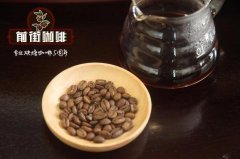How about African Ethiopian Coffee A brief introduction to the characteristics of Coffee in Gucci Coffee producing area

Professional coffee knowledge exchange more coffee bean information please follow the coffee workshop (Wechat official account cafe_style)
Qianjie-brief introduction of Ethiopian Coffee and Guji producing areas
Ethiopia has the most diverse coffee ecosystem in the world (forest coffee, semi-forest coffee, pastoral coffee and plantation coffee), which enables the preservation of its rich Arabica genes, coupled with multiple treatments of sun, water and semi-washing, showing a complex and varied flavor. It can be said that most of the "taste spectrum" of coffee producing areas around the world can be drunk here, reflecting Ethiopia's inclusive "king flavor".
The coffee-producing region of Ethiopia is divided into east and west parts by the East African Rift Valley, with lakes, volcanoes, lowlands, plateaus and woodlands interlaced, each evolving. Most of the eastern half is the plateau, and the coffee beans taste better, such as Yega Scherffe and Sidamo, which are popular with bright sour taste, and Hara, which is charming and "miscellaneous"; the western half is covered with a large area of primeval forest, and most of them are in the process of completely natural evolution. it has created a more complex variety of coffee, and the coffee varieties in the Kafa forest in the southwest are highly resistant to disease. Due to natural evolution and less manual screening, its overall flavor is slightly lower than that of the eastern half of the wall.
GUJI is the largest coffee producing area in Ethiopia. Sakui comes from Hambella, one of the offspring of Guji, which is processed by Buku Abel Manor.
Treatment method
The sun treatment is very exquisite. The sugar content of cherry must reach 30 degrees before they can meet the picking standard and can be treated in the sun. The first two days of the sun are very important, and the humidity of the cherry must be kept at a certain value before the fructose in the cherry begins to ferment. In addition to humidity, temperature is also one of the factors affecting the treatment of coffee beans. During the annual coffee harvest season, the climate in Ethiopia is cool, and the night temperature in the processing plant is about 12 degrees Celsius. Coffee beans on the drying bed avoid excessive fermentation and smell because of the lower temperature.
At noon when the temperature is high, the coffee cherry is shielded from sunburn, and in the evening, the coffee fruit is protected by showers and covered with thick plastic sheeting. After about 18 days of careful cooking, the moisture content of raw beans decreased to about 13, and the sun treatment was completed. The raw coffee beans were put into sacks and stored in the warehouse for 50 days to further reduce their moisture content. The moisture content of raw beans is reduced to about 11, and then transported to the treatment plant for shelling, grading and sales.
Knowledge gift: Wulaga Uraga producing area is a very new small producing area, located in Guji, has always been covered by the name of Guji, no one knows, until this year won the TOH?? The champion of the washing group officially entered the public view. It is the highest coffee producing area in Ethiopia, which makes the coffee in this area full of lively and changeable flavor.
END
Important Notice :
前街咖啡 FrontStreet Coffee has moved to new addredd:
FrontStreet Coffee Address: 315,Donghua East Road,GuangZhou
Tel:020 38364473
- Prev

What are the quality characteristics of Essel coffee beans? what is the difference in flavor between Yega Xuefei washing and sun treatment?
Professional coffee knowledge exchange more coffee bean information please follow the coffee workshop (Wechat official account cafe_style) front street-Ethiopia coffee ranking, washing, sun exposure brief introduction with unique natural conditions in Ethiopia, suitable for growing all imaginable coffee varieties. Esseobi
- Next

What is the best coffee brand in Ethiopia? share the brewing parameters of Kongjia coffee.
Professional coffee knowledge exchange more coffee bean information please follow the coffee workshop (Wechat official account cafe_style) front street-Ethiopia-Yega Feikonga Coffee introduction Ethiopia, located in a country full of magic, Arabica coffee tree originated in Ethiopia (Ethiopia), it was originally a wild plant here, the name coffee comes from Ethiopia.
Related
- Beginners will see the "Coffee pull flower" guide!
- What is the difference between ice blog purified milk and ordinary milk coffee?
- Why is the Philippines the largest producer of crops in Liberia?
- For coffee extraction, should the fine powder be retained?
- How does extracted espresso fill pressed powder? How much strength does it take to press the powder?
- How to make jasmine cold extract coffee? Is the jasmine + latte good?
- Will this little toy really make the coffee taste better? How does Lily Drip affect coffee extraction?
- Will the action of slapping the filter cup also affect coffee extraction?
- What's the difference between powder-to-water ratio and powder-to-liquid ratio?
- What is the Ethiopian local species? What does it have to do with Heirloom native species?

